Enhanced Corrosion Protection of Epoxy/ZnO-NiO Nanocomposite Coatings on Steel
Abstract
1. Introduction
2. Experimental
2.1. Materials
2.2. Preparation of ZnO/NiO Nanocomposite
2.3. Preparation of Pure Epoxy
2.4. Preparation of Epoxy/ZnO/NiO Nanocomposites
2.5. Different Steps for the Preparation of Epoxy with Metal Oxide Composites
2.6. Corrosion Behavior of Steel Before and After the Coating
2.7. Characterization
2.8. Electrochemical Experiments
3. Results and Discussion
3.1. Structural and Morphological Analysis of the ZnO/NiO Composite
3.2. Potentiodynamic Polarization (PP) Characterization
3.3. EIS Characterization
3.4. Corrosion Inhibition Mechanism
4. Conclusions
Author Contributions
Funding
Acknowledgments
Conflicts of Interest
References
- Javidparvar, A.A.; Naderi, R.; Ramezanzadeh, B. Manipulating graphene oxide nanocontainer with benzimidazole and cerium ions: Application in epoxy-based nanocomposite for active corrosion protection. Corros. Sci. 2020, 165, 108379. [Google Scholar] [CrossRef]
- Aslam, J.; Mobin, M.; Aslam, R.; Ansar, F. Corrosion protection of low carbon steel by conducting terpolymer nanocomposite coating in 3.5 wt% NaCl solution. J. Adhes. Sci. Technol. 2020, 34, 443–460. [Google Scholar] [CrossRef]
- Shen, L.; Li, Y.; Zhao, W.; Wang, K.; Ci, X.; Wu, Y.; Liu, G.; Liu, C.; Fang, Z. Tuning F-doped degree of rGO: Restraining corrosion-promotion activity of EP/rGO nanocomposite coating. J. Mater. Sci. Technol. 2020, 44, 121–132. [Google Scholar] [CrossRef]
- Mandal, S.; Das, V.V.; Debata, M.; Panigrahi, A.; Sengupta, P.; Rajendran, A.; Pattanayak, D.K.; Basu, S. Study of pore morphology, microstructure, and cell adhesion behaviour in porous Ti-6Al-4V scaffolds. Emerg. Mater. 2019, 2, 453–462. [Google Scholar] [CrossRef]
- Fayyad, E.M.; Abdullah, A.M.; Hassan, M.K.; Mohamed, A.M.; Jarjoura, G.; Farhat, Z. Recent advances in electroless-plated Ni-P and its composites for erosion and corrosion applications: A review. Emerg. Mater. 2018, 1, 3–24. [Google Scholar] [CrossRef]
- Cooke, K.O.; Khan, T.I. Effect of thermal processing on the tribology of nanocrystalline Ni/TiO2 coatings. Emerg. Mater. 2018, 1, 165–173. [Google Scholar] [CrossRef]
- Boomadevi Janaki, G.; Xavier, J.R. Evaluation of Mechanical Properties and Corrosion Protection Performance of Surface Modified Nano-alumina Encapsulated Epoxy Coated Mild Steel. J. Bio Tribo Corros. 2020, 6, 20. [Google Scholar] [CrossRef]
- Patel, D.; Makwana, K.; Shirdhonkar, M.B.; Kuperkar, K.C. Electrochemical response and computational approach on surface-active ionic liquid (SAIL) in metal corrosion inhibition. Emerg. Mater. 2020, 3, 161–168. [Google Scholar] [CrossRef]
- Kannan, K.; Sivasubramanian, D.; Seetharaman, P.; Sivaperumal, S. Structural and biological properties with enhanced photocatalytic behaviour of CdO-MgO nanocomposite by microwave-assisted method Optik 2020, 204, 164221. Optik 2020, 204, 164221. [Google Scholar] [CrossRef]
- Kannan, K.; Radhika, D.; Nikolova, M.P.; Sadasivuni, K.K.; Mahdizadeh, H.; Verma, U. Structural studies of bio-mediated NiO nanoparticles for photocatalytic and antibacterial activities. Inorg. Chem. Commun. 2020, 113, 107755. [Google Scholar] [CrossRef]
- Kannan, K.; Radhika, D.; Vijayalakshmi, S.; Sadasivuni, K.K.; Ojiaku, A.A.; Verma, U. Facile fabrication of CuO nanoparticles via microwave-assisted method: Photocatalytic, antimicrobial and anticancer enhancing performance. Int. J. Environ. Anal. Chem. 2020. [Google Scholar] [CrossRef]
- Popoola, A.P.I.; Aigbodion, V.S.; Fayomi, O.S.I. Anti-corrosion coating of mild steel using ternary Zn-ZnO-Y2O3 electrodeposition. Surf. Coat. Technol. 2016, 306, 448–454. [Google Scholar] [CrossRef]
- Fayomi, O.S.I.; Popoola, A.P.I.; Aigbodion, V.S. Investigation on microstructural, anti-corrosion and mechanical properties of doped Zn–Al–SnO2 metal matrix composite coating on mild steel. J. Alloy. Compd. 2015, 623, 328–334. [Google Scholar] [CrossRef]
- Malatji, N.; Popoola, A.P.I.; Fayomi, O.S.I.; Loto, C.A. Multifaceted incorporation of Zn-Al2O3/Cr2O3/SiO2 nanocomposite coatings anti-corrosion tribological and thermal stability. Int. J. Adv. Manuf. Technol. 2016, 82, 1335–2134. [Google Scholar] [CrossRef]
- Kallappa, D.; Venkatarangaiah, V.T. Synthesis of CeO2 doped ZnO nanoparticles and their application in Zn-composite coating on mild steel. Arab. J. Chem. 2020, 13, 2309–2317. [Google Scholar] [CrossRef]
- Wadhwani, P.M.; Ladha, D.G.; Panchal, V.K.; Shah, N.K. Enhanced corrosion inhibitive effect of p-methoxybenzylidene-4,4’-dimorpholine assembled on nickel oxide nanoparticles for mild steel in acid medium. RSC Adv. 2015, 5, 7098–7111. [Google Scholar] [CrossRef]
- Shajudheen, V.M.; Kumar, V.S.; Maheswari, A.U.; Sivakumar, M.; Kumar, S.S.; Rani, K.A. Characterization and anticorrosion studies of spray coated nickel oxide (NiO) thin films. Mater. Today Proceed. 2018, 5, 8577–8586. [Google Scholar] [CrossRef]
- Aruna, S.T.; Bindu, C.N.; Ezhil Selvi, V.; William Grips, V.K.; Rajam, K.S. Synthesis and properties of electrodeposited Ni/ceria nanocomposite coatings. Surf. Coat. Technol. 2006, 200, 6871–6880. [Google Scholar] [CrossRef]
- Suresh, K.C.; Balamurugan, A. Evaluation of structural, optical, and morphological properties of nickel oxide nanoparticles for multi-functional applications. Inorg. Nano-Metal Chem. 2020. [Google Scholar] [CrossRef]
- Xue, Y.J.; Jia, X.Z.; Zhou, Y.W.; Ma, W.; Li, J.S. Tribological performance of Ni–CeO2 composite coatings by electrodeposition. Surf. Coat. Technol. 2006, 200, 5677–5681. [Google Scholar] [CrossRef]
- Shajudheen, V.M.; Rani, K.A.; Kumar, V.S.; Maheswari, A.U.; Sivakumar, M.; Kumar, S.S. Comparison of Anticorrosion Studies of Titanium Dioxide and Nickel Oxide Thin Films Fabricated by Spray Coating Technique. Mater. Today Proceed. 2018, 5, 8889–8898. [Google Scholar] [CrossRef]
- Deng, S.H.; Lu, H.; Li, D.Y. Influence of UV light irradiation on the corrosion behavior of electrodeposited Ni and Cu nanocrystalline foils. Sci. Rep. 2020, 10, 3049. [Google Scholar] [CrossRef] [PubMed]
- Karthik, K.; Revathi, V.; Tatarchuk, T. Microwave-assisted green synthesis of SnO2 nanoparticles and their optical and photocatalytic properties. Mol. Cryst. Liquid Cryst. 2018, 671, 17–23. [Google Scholar] [CrossRef]
- Bukkitgar, S.D.; Shetti, N.P.; Kulkarni, R.M.; Reddy, K.R.; Shukla, S.S.; Saji, V.S.; Aminabhavi, T.M. Electro-catalytic behavior of Mg-doped ZnO nano-flakes for oxidation of anti-inflammatory drug. J. Electrochem. Soc. 2019, 166, B3072–B3078. [Google Scholar] [CrossRef]
- Xavier, J.R. Effect of surface modified WO3 nanoparticles on the epoxy coatings for the adhesive and anticorrosion properties of mild steel. J. Appl. Polym. Sci. 2019, 137, 48323. [Google Scholar] [CrossRef]
- Yu, Z.; Di, H.; Ma, Y.; Lv, L.; Pan, Y.; Zhang, C.; He, Y. Fabrication of graphene oxide–alumina hybrids to reinforce the anti-corrosion performance of composite epoxy coatings. Appl. Surf. Sci. 2015, 351, 986–996. [Google Scholar] [CrossRef]
- Mirabedini, S.M.; Moradian, S.; Scantlebury, J.D.; Thompson, G.E. Characterization and corrosion performance of powder coated aluminium alloy. Iran Polym. J. 2003, 12, 261–270. [Google Scholar]
- Hadavand, B.S.; Ataeefard, M.; Bafghi, H.F. Preparation of modified nano ZnO/polyester/TGIC powder coating nanocomposite and evaluation of its antibacterial activity. Compos. Part B Eng. 2015, 82, 190–195. [Google Scholar] [CrossRef]
- Ashassi-Sorkhabi, H.; Seifzadeh, D.; Raghibi-Boroujeni, M. Analysis of electrochemical noise data in both time and frequency domains to evaluate the effect of ZnO nanopowder addition on the corrosion protection performance of epoxy coatings. Arab. J. Chem. 2016, 9, S1320–S1327. [Google Scholar] [CrossRef]
- Xavier, J.R. Application of EIS and SECM studies for investigation of anticorrosion properties of epoxy coatings containing zinc oxide nanoparticles on mild steel in 3.5% NaCl solution. J. Mater. Eng. Perform. 2017, 26, 3245–3253. [Google Scholar]
- Madhankumar, A.; Ramakrishna, S.; Sudhagar, P.; Kim, H.; Kang, Y.S.; Obot, I.B.; Gasem, Z.M.A. An electrochemical, in vitro bioactivity and quantum chemical approach to nanostructured copolymer coatings for orthopedic applications. J. Mater. Sci. 2014, 49, 4067–4080. [Google Scholar] [CrossRef]
- Jeyasubramanian, K.; Benitha, V.S.; Parkavi, V. Nano iron oxide dispersed alkyd coating as an efficient anticorrosive coating for industrial structures. Prog. Org. Coat. 2019, 132, 76–85. [Google Scholar] [CrossRef]
- Krishnan, A.; Joseph, B.; Bhaskar, K.M.; Suma, M.S.; Shibli, S.M.A. Unfolding the anticorrosive characteristics of TiO2–WO3 mixed oxide reinforced polyaniline composite coated mild steel in alkaline environment. Polym. Compos. 2018, 40, 2400–2409. [Google Scholar] [CrossRef]
- Al-Gamal, A.G.; Farag, A.A.; Elnaggar, E.M.; Kabel, K.I. Comparative impact of doping nano-conducting polymer with carbon and carbon oxide composites in alkyd binder as anti-corrosive coatings. Compos. Interfaces 2018, 25, 959–980. [Google Scholar] [CrossRef]
- Pourhashem, S.; Vaezi, M.R.; Rashidi, A.; Bagherzadeh, M.R. Exploring corrosion protection properties of solvent based epoxy-graphene oxide nanocomposite coatings on mild steel. Corros. Sci. 2016, 115, 78–92. [Google Scholar] [CrossRef]
- Deshpande, P.P.; Jadhav, N.G.; Gelling, V.J.; Sazou, D. Conducting polymers for corrosion protection: A review. J. Coat. Technol. Res. 2014, 11, 473–494. [Google Scholar] [CrossRef]
- Ghasemi-Kahrizsangi, A.; Shariatpanahi, H.; Neshati, J.; Akbarinezhad, E. Corrosion behavior of modified nano carbon black/epoxy coating in accelerated conditions. Appl. Surf. Sci. 2015, 331, 115–126. [Google Scholar] [CrossRef]
- Wu, L.K.; Zhang, J.T.; Hu, J.M.; Zhang, J.Q. Improved corrosion performance of electrophoretic coatings by silane addition. Corros. Sci. 2012, 56, 58–66. [Google Scholar] [CrossRef]
- Bayat, S.; Jazani, O.M.; Molla-Abbasi, P.; Jouyandeh, M.; Saeb, M.R. Thin films of epoxy adhesives containing recycled polymers and graphene oxide nanoflakes for metal/polymer composite interface. Prog. Org. Coat. 2019, 136, 105201. [Google Scholar] [CrossRef]
- Xavier, J.R. Investigation on the anticorrosion, adhesion and mechanical performance of epoxy nanocomposite coatings containing epoxy-silane treated nano MoO3 on mild steel. J. Adhes. Sci. Technol. 2020, 34, 115–134. [Google Scholar] [CrossRef]
- Shen, G.X.; Chen, Y.C.; Lin, C.J. Corrosion protection of 316L stainless steel by a TiO2 nanoparticles coating prepared by sol–gel method. Thin Solid Films 2005, 489, 130–136. [Google Scholar] [CrossRef]
- Shan, C.X.; Hou, X.; Choy, K.L.; Choquet, P. Improvement in corrosion resistance of CrN coated stainless steel by conformal TiO2 deposition. Surf. Coat. Technol. 2008, 202, 2147–2151. [Google Scholar] [CrossRef]
- Díaz, B.; Światowska, J.; Maurice, V.; Pisarek, M.; Seyeux, A.; Zanna, S.; Tervakangas, S.; Kolehmainen, J.; Marcus, P. Chromium and tantalum oxide nanocoatings prepared by filtered cathodic arc deposition for corrosion protection of carbon steel. Surf. Coat. Technol. 2012, 206, 3903–3910. [Google Scholar] [CrossRef]
- Mirhashemihaghighi, S.; Światowska, J.; Maurice, V.; Seyeux, A.; Klein, L.H.; Salmi, E.; Ritala, M.; Marcus, P. The role of surface preparation in corrosion protection of copper with nanometer-thick ALD alumina coatings. Appl. Surf. Sci. 2016, 387, 1054–1061. [Google Scholar] [CrossRef]
- Nouri, E.; Shahmiri, M.; Rezaie, H.R.; Talayian, F. Investigation of structural evolution and electrochemical behaviour of zirconia thin films on the 316L stainless steel substrate formed via sol–gel process. Surf. Coat. Technol. 2011, 205, 5109–5115. [Google Scholar] [CrossRef]
- Fayyad, E.M.; Sadasivuni, K.K.; Ponnamma, D.; Al-Maadeed, M.A.A. Oleic acid-grafted chitosan/graphene oxide composite coating for corrosion protection of carbon steel. Carbohydr. Polym. 2016, 151, 871–878. [Google Scholar] [CrossRef]
- Mahato, N.; Cho, M.H. Graphene integrated polyaniline nanostructured composite coating for protecting steels from corrosion: Synthesis, characterization, and protection mechanism of the coating material in acidic environment. Constr. Build. Mater. 2016, 115, 618–633. [Google Scholar] [CrossRef]
- Feng, Q.; Li, T.; Teng, H.; Zhang, X.; Zhang, Y.; Liu, C.; Jin, J. Investigation on the corrosion and oxidation resistance of Ni-Al2O3 nano-composite coatings prepared by sediment co-deposition. Surf. Coat. Technol. 2008, 202, 4137–4144. [Google Scholar] [CrossRef]
- Benea, L.; Luigi, P.; Borello, A.; Martelli, S. Wear corrosion properties of nano-structured SiC-nickel composite coatings obtained by electroplating. Wear 2002, 249, 995–1003. [Google Scholar] [CrossRef]
- Ranganatha, S.; Venkatesha, T.V.; Vathsala, K. Development of electroless Ni-Zn-P/nano-TiO2 composite coatings and their properties. Appl. Surf. Sci. 2010, 256, 7377–7383. [Google Scholar] [CrossRef]
- Cai, C.; Zhu, X.B.; Zheng, G.Q.; Yuan, Y.N.; Huang, X.Q.; Cao, F.H.; Yang, J.F.; Zhang, B. Electrodeposition and characterization of nano-structured Ni-SiC composite films. Surf. Coat. Technol. 2011, 205, 3448–3454. [Google Scholar] [CrossRef]
- Bigdeli, F.; Allahkaram, S.R. An investigation on corrosion resistance of as-applied and heat treated Ni-P/nanoSiC coatings. Mater. Des. 2009, 30, 4450–4453. [Google Scholar] [CrossRef]
- Rabizadeh, T.; Allahkaram, S.R. Corrosion resistance enhancement of Ni-P electroless coatings by incorporation of nano-SiO2 particles. Mater. Des. 2011, 32, 133–138. [Google Scholar] [CrossRef]
- Xavier, J.R. Investigation into the effect of Cr2O3 nanoparticles on the protective properties of epoxy coatings on carbon steel in NaCl solution by scanning electrochemical microscopy. Prot. Met. Phys. Chem. 2019, 55, 80–88. [Google Scholar] [CrossRef]
- Nine, M.J.; Cole, M.A.; Johnson, L.; Tran, D.N.; Losic, D. Robust superhydrophobic graphene-based composite coatings with self-cleaning and corrosion barrier properties. ACS Appl. Mater. Interfaces 2015, 7, 28482–28493. [Google Scholar] [CrossRef] [PubMed]
- Kannan, K.; Sliem, M.H.; Abdullah, A.M.; Sadasivuni, K.K.; Kumar, B. Fabrication of ZnO-Fe-MXene Based Nanocomposites for Efficient CO2 Reduction. Catalysts 2020, 10, 549. [Google Scholar] [CrossRef]
- Kannan, K.; Sadasivuni, K.K.; Abdullah, A.M.; Kumar, B. Current Trends in MXene-Based Nanomaterials for Energy Storage and Conversion System: A Mini Review. Catalysts 2020, 10, 495. [Google Scholar] [CrossRef]
- Jamwal, A.; Prakash, P.; Kumar, D.; Singh, N.; Sadasivuni, K.K.; Harshit, K.; Gupta, S.; Gupta, P. Microstructure, wear and corrosion characteristics of Cu matrix reinforced SiC–graphite hybrid composites. J. Compos. Mater. 2019, 53, 2545–2553. [Google Scholar] [CrossRef]
- Bandil, K.; Vashisth, H.; Kumar, S.; Verma, L.; Jamwal, A.; Kumar, D.; Singh, N.; Sadasivuni, K.K.; Gupta, P. Microstructural, mechanical and corrosion behaviour of Al–Si alloy reinforced with SiC metal matrix composite. J. Compos. Mater. 2019, 53, 4215–4223. [Google Scholar] [CrossRef]
- Ejenstam, L.; Tuominen, M.; Haapanen, J.; Mäkelä, J.M.; Pan, J.; Swerin, A.; Claesson, P.M. Long-term corrosion protection by a thin nano-composite coating. Appl. Surf. Sci. 2015, 357, 2333–2342. [Google Scholar] [CrossRef]
- Kinlen, P.J.; Silverman, D.C.; Jeffreys, C.R. Corrosion protection using polyamine coating formulations. Synth. Met. 1997, 85, 1327–1332. [Google Scholar] [CrossRef]
- Chen, L.; Song, R.G.; Li, X.W.; Guo, Y.Q.; Wang, C.; Jiang, Y. The improvement of corrosion resistance of fluoropolymer coatings by SiO2/poly(styrene-co-butyl acrylate) nanocomposite particles. Appl. Surf. Sci. 2015, 353, 254–262. [Google Scholar] [CrossRef]
- Dhoke, S.K.; Mangal Sinha, T.J.; Khanna, A.S. Effect of nano-Fe2O3 particles on the corrosion behavior of alkyd based waterborne coatings. J. Coat. Technol. Res. 2009, 6, 353–368. [Google Scholar] [CrossRef]
- Dhoke, S.K.; Khanna, A.S.; Sinha, T.J.M. Effect of nano-ZnO particles on the corrosion behavior of alkyd-based waterborne coatings. Progress Org. Coat. 2009, 64, 371–382. [Google Scholar] [CrossRef]
- Vaezi, M.R.; Sadrnezhaad, S.K.; Nikzad, L. Electrodeposition of Ni-SiC nano-composite coatings and evaluation of wear and corrosion resistance and electroplating characteristics. Colloids Surf. A Physicochem. Eng. Asp. 2008, 315, 176–182. [Google Scholar] [CrossRef]
- Allahkaram, S.R.; Nazari, M.H.; Mamaghani, S.; Zarebidaki, A. Characterization and corrosion behavior of electroless Ni-P/nano-SiC coating inside the CO2 containing media in the presence of acetic acid. Mater. Des. 2011, 32, 750–755. [Google Scholar] [CrossRef]
- Feng, L.; Yuan, P. Corrosion protection mechanism of aluminum triphosphate modified by organic acids as a rust converter. Prog. Org. Coat. 2020, 140, 105508. [Google Scholar] [CrossRef]
- Gobara, M.; Baraka, A.; Akid, R.; Zorainy, M. Corrosion protection mechanism of Ce4+/organic inhibitor for AA2024 in 3.5% NaCl. RSC Adv. 2020, 10, 2227–2240. [Google Scholar] [CrossRef]
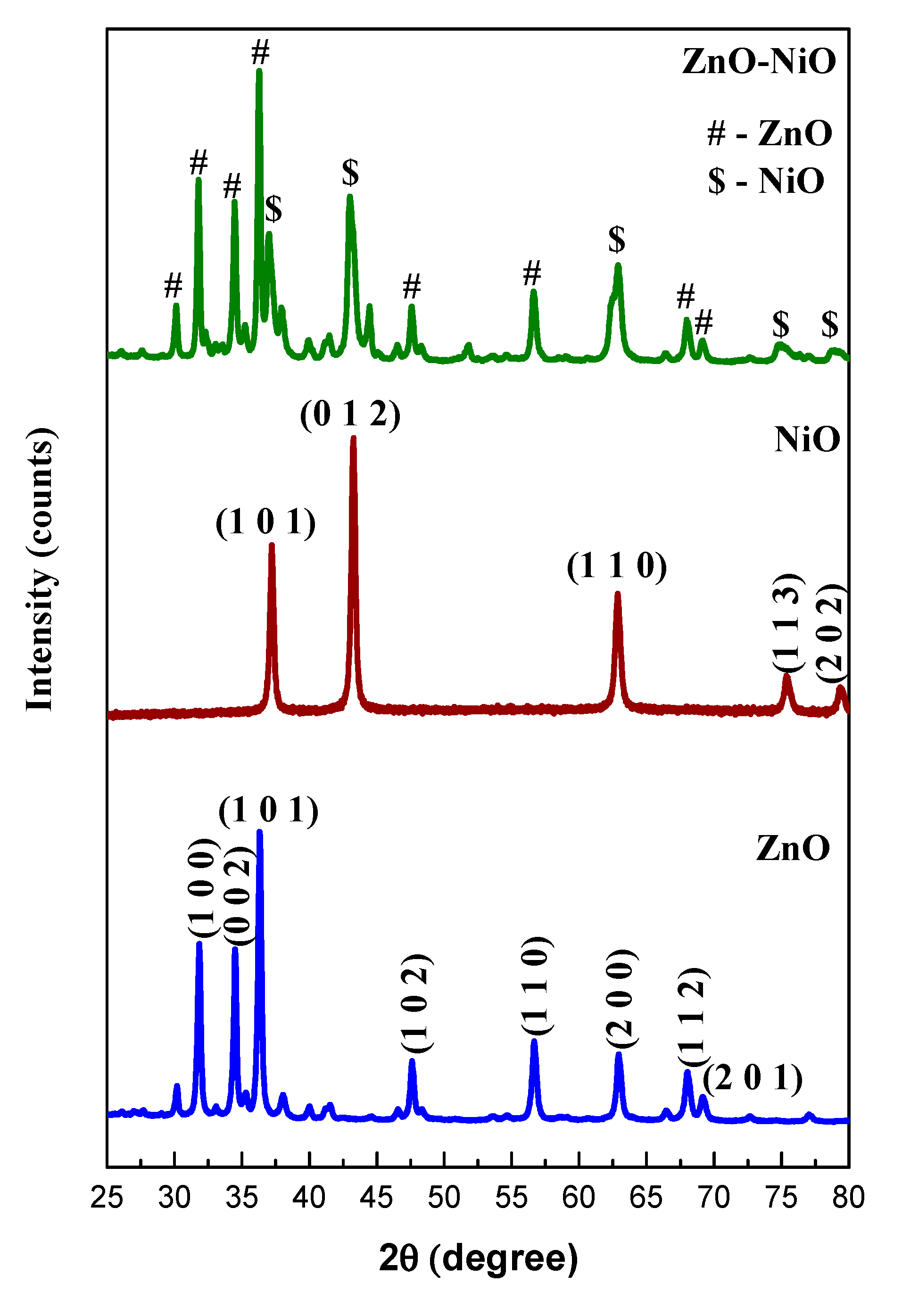
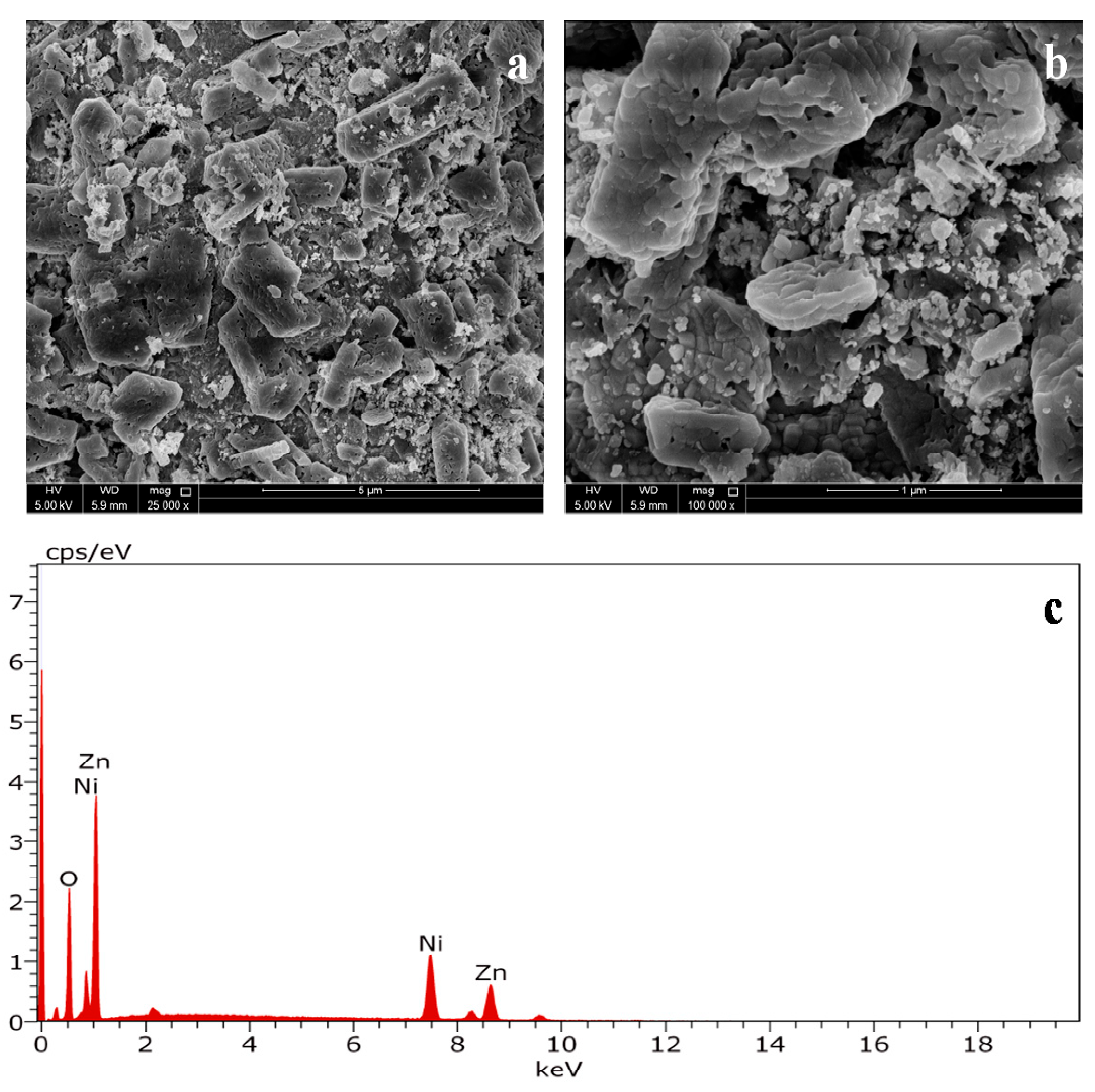
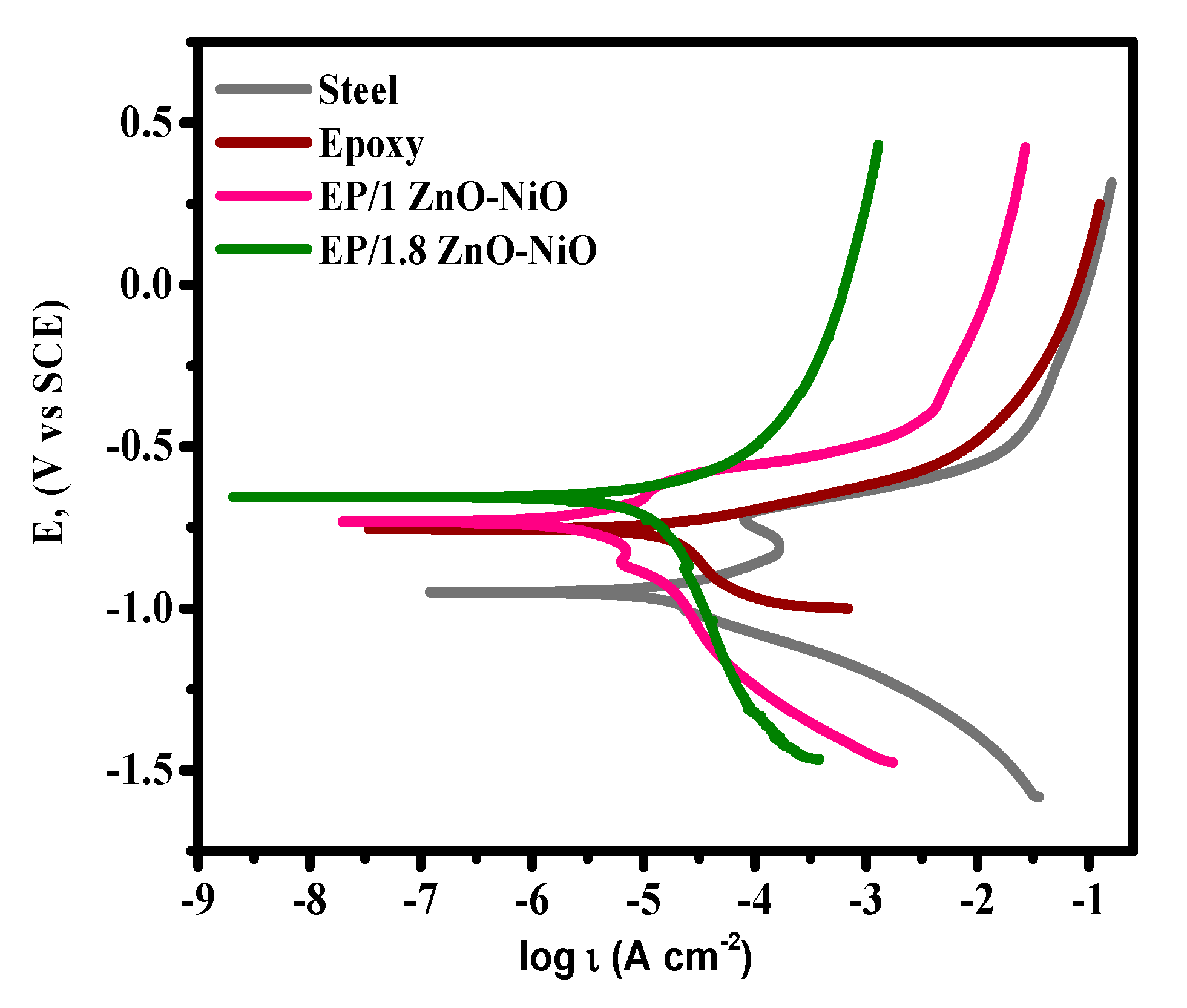
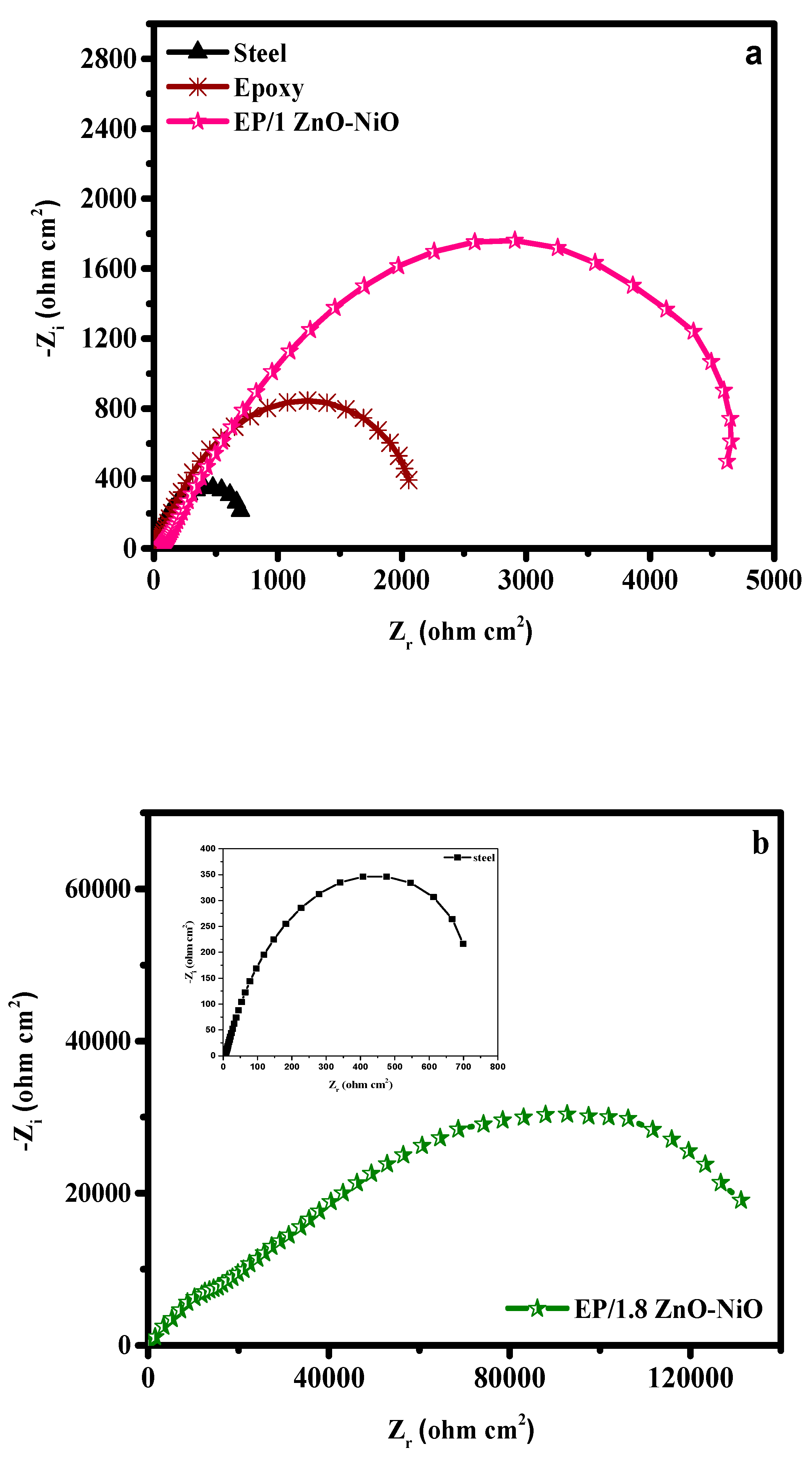
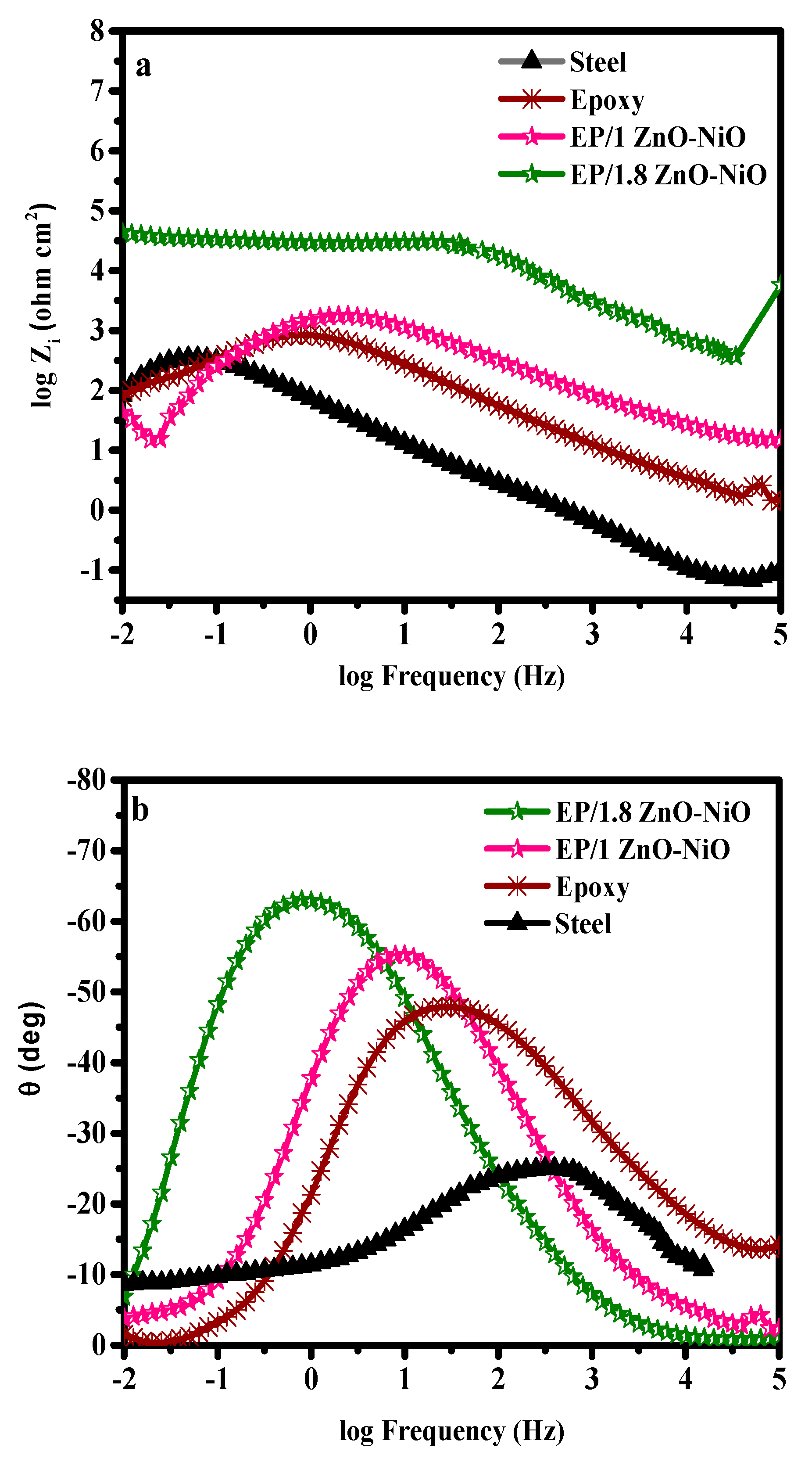
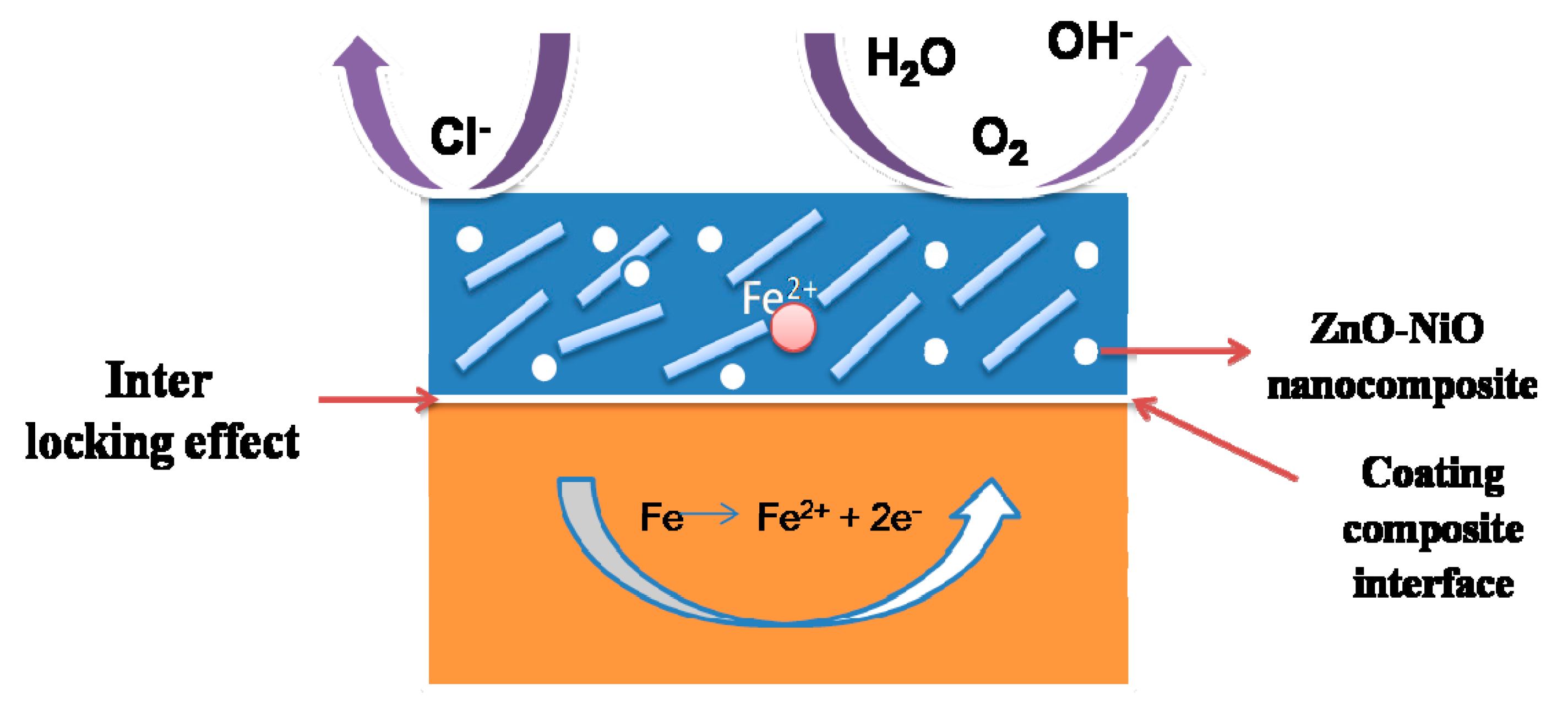
| Material | Phases | Lattice Constant (nm) | D (nm) D = kλ/βcosθ | (δ) × 1014 (Lines/m2) δ = 1/D2 |
|---|---|---|---|---|
| ZnO | hexagonal | a = 0.3234 c = 0.5165 | 41 | 5.95 |
| NiO | cubic | a = 0.4175 | 28 | 12.8 |
| ZnO-NiO | ZnO (hexagonal) | a = 0.4218 c = 0.5191 | 34 | 8.65 |
| NiO (cubic) | a = 0.4170 | 18 | 30.9 |
| Samples | Ecorr (V) | Icorr (μA/cm2) | ba (V/Decade) | bc (V/Decade) | Corrosion Rate (mpy) |
|---|---|---|---|---|---|
| Steel | −0.97 | 95.49 | 0.38 | 0.42 | 43.99 |
| Epoxy | −0.91 | 18.62 | 0.21 | 0.36 | 8.57 |
| EP/1 ZnO-NiO | −0.79 | 13.18 | 0.12 | 0.17 | 6.07 |
| EP/1.8 ZnO-NiO | −0.68 | 5.37 | 0.11 | 0.11 | 2.47 |
| Sample | Substrate | Medium | Ecorr (V) | Icorr (μA/cm2) | Ref. |
|---|---|---|---|---|---|
| TiO2 nanoparticles | 316L stainless steel | 0.5 mol/L NaCl solution | −0.117 | 0.783 | [41] |
| Amorphous TiO2 nanoparticles (CrN/TiO2) | 316L stainless steel | 3 wt.% NaCl solution | −0.49 | 0.00031 | [42] |
| Ta2O5 thin films | Carbon steel | 0.2 M NaCl solution | −0.671 | 0.0348 | [43] |
| Al2O3 thin films | Copper | 0.5 M NaCl solution | −0.308 | 2.71 | [44] |
| ZrO2 thin films | 316L stainless steel | 1M H2SO4 solution | −0.1814 | 3.11 | [45] |
| CS/GO-OA | Carbon steel | 3.5 wt.% NaCl solution | −0.374 | 3.9 | [46] |
| Graphene/polyaniline | Mild steel | 0.1 M HCl (pH = 1) | −0.532 | 0.572 | [47] |
| Al2O3/Ni | Mild steel | 3.5 wt.% NaCl solution | −0.253 | 0.011 | [48] |
| SiC/Ni | Carbon steel | 0.5 M Na2SO4 | −0.2605 | 1.9 | [49] |
| TiO2-Ni-Zn-P | Low carbon steel | 3.5 wt.% NaCl solution | −0.404 | 0.364 | [50] |
| SiC-Ni | Copper | 3.5 wt.% NaCl solution | −0.248 | 0.6645 | [51] |
| SiC-Ni-P | St37 tool steel | 3.5 wt.% NaCl solution | −0.255 | 1.58 | [52] |
| SiO2-Ni-P | API-5LX65 steel | 3.5 wt.% NaCl solution | −0.336 | 0.308 | [53] |
| EP/1.8 ZnO-NiO | Steel | 3.5 wt.% NaCl solution | −0.68 | 5.37 | Present study |
© 2020 by the authors. Licensee MDPI, Basel, Switzerland. This article is an open access article distributed under the terms and conditions of the Creative Commons Attribution (CC BY) license (http://creativecommons.org/licenses/by/4.0/).
Share and Cite
Ibrahim, M.; Kannan, K.; Parangusan, H.; Eldeib, S.; Shehata, O.; Ismail, M.; Zarandah, R.; Sadasivuni, K.K. Enhanced Corrosion Protection of Epoxy/ZnO-NiO Nanocomposite Coatings on Steel. Coatings 2020, 10, 783. https://doi.org/10.3390/coatings10080783
Ibrahim M, Kannan K, Parangusan H, Eldeib S, Shehata O, Ismail M, Zarandah R, Sadasivuni KK. Enhanced Corrosion Protection of Epoxy/ZnO-NiO Nanocomposite Coatings on Steel. Coatings. 2020; 10(8):783. https://doi.org/10.3390/coatings10080783
Chicago/Turabian StyleIbrahim, Muna, Karthik Kannan, Hemalatha Parangusan, Shady Eldeib, Omar Shehata, Mohammad Ismail, Ranin Zarandah, and Kishor Kumar Sadasivuni. 2020. "Enhanced Corrosion Protection of Epoxy/ZnO-NiO Nanocomposite Coatings on Steel" Coatings 10, no. 8: 783. https://doi.org/10.3390/coatings10080783
APA StyleIbrahim, M., Kannan, K., Parangusan, H., Eldeib, S., Shehata, O., Ismail, M., Zarandah, R., & Sadasivuni, K. K. (2020). Enhanced Corrosion Protection of Epoxy/ZnO-NiO Nanocomposite Coatings on Steel. Coatings, 10(8), 783. https://doi.org/10.3390/coatings10080783







